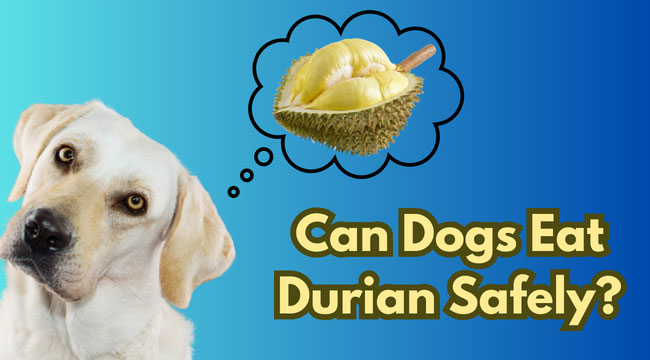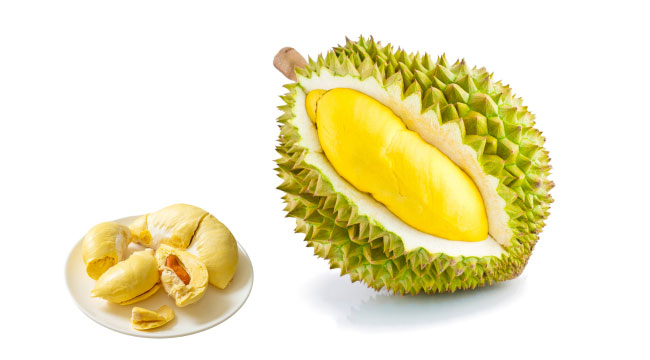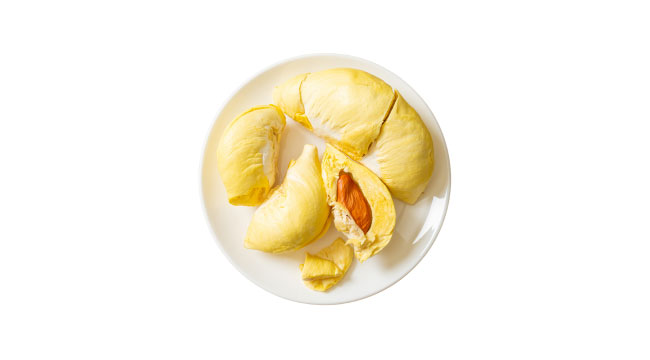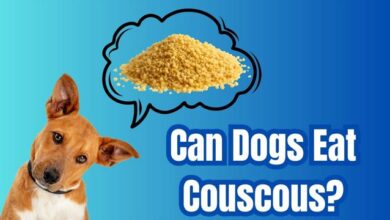
The durian fruit, famous for its strong smell and spiky shell, might catch your dog’s attention. But can dogs eat durian safely? The answer is maybe, but you need to be very careful. While the soft part of the fruit isn’t poisonous, durian has hidden dangers. The seeds contain cyanide (a harmful poison), the sharp skin can choke your dog, and the high fat content might cause stomach problems like pancreatitis. Some pet owners wonder if the vitamins in durian, like vitamin C, make it worth the risk—but most vets say no.
This guide explains how to keep your dog safe. You’ll learn how to remove dangerous seeds and skin, spot signs of poisoning, and find healthier treats like apples or blueberries. If your dog accidentally eats durian, we’ll tell you what to do next. Let’s break down the facts so you can make the best choices for your furry friend!
What Is Durian?

Durian is a large, tropical fruit known for its strong smell and spiky, hard shell. It grows in countries like Thailand, Malaysia, and Indonesia. People often call it the “king of fruits” because of its unique taste and size. The fruit can be as big as a football!
The inside of a durian has soft, creamy flesh that is sweet and rich. Some people love its flavor, while others find the smell overwhelming—it’s often compared to a mix of rotten onions and sweet custard. Durian is eaten fresh or used in foods like cakes, ice cream, and candies.
Parts of a Durian:
- Flesh: The soft, edible part. It’s high in fat and natural sugars.
- Seeds: Found inside the flesh. These are large and contain cyanide, a dangerous poison.
- Skin: Thick, spiky, and very hard. It can hurt your dog’s mouth or throat.
While humans enjoy durian, it’s risky for dogs. Even the flesh, though not poisonous, has too much fat and sugar for most dogs. Processed durian snacks (like ice cream) often add harmful ingredients like chocolate, sugar, or xylitol. Always keep durian away from your pup!
Is Durian Safe for Dogs? Breaking Down the Risks
Durian is a large, spiky fruit with three main parts: the flesh, seeds, and tough outer skin. The soft, creamy flesh is the part humans eat, but it’s high in fat and natural sugars. The seeds are hidden inside the flesh, and the skin is sharp and prickly. Durian’s strong smell—often compared to rotten onions or sulfur—might make some dogs curious, but others might avoid it.
Toxic Elements in Durian
While the flesh isn’t poisonous, durian has hidden dangers. Seeds contain cyanide, a toxic chemical that can harm dogs if eaten. The spiky skin can cut your dog’s mouth or throat, and swallowing it might cause choking or blockages in their stomach. Store-bought durian products (like ice cream or snacks) often have added seasonings like garlic or salt, which are also unsafe for dogs.
Nutritional Value vs. Health Risks
Potential Benefits of Durian Flesh
Durian flesh has small amounts of vitamins B6 and C, potassium, and antioxidants, which support your dog’s immune system and muscles. However, these benefits are minimal compared to the risks. A tiny bite (less than a teaspoon for small dogs) is the most you should ever offer.
Why Durian’s Risks Outweigh Benefits
The high fat in durian can cause pancreatitis (a painful pancreas inflammation), while the sugar may lead to obesity or diabetes over time. Even small amounts can upset your dog’s stomach, causing vomiting or diarrhea. For most dogs, the dangers of seeds, skin, and fatty flesh make durian a treat to avoid.
Related Post: Can Dogs Eat Couscous? How Much Is Safe?
Immediate Dangers: Seeds, Skin, and Seasonings

Durian Seeds: Cyanide Toxicity
Durian seeds are very dangerous for dogs. Even a small amount can cause serious problems. The seeds are large and hard, making them easy to choke on or get stuck in your dog’s stomach or intestines. More importantly, durian seeds contain cyanide, a poison that can harm your dog’s body and brain. Eating these seeds can lead to trouble breathing, weakness, seizures, or even death if not treated quickly. If your dog eats a durian seed, get help from a vet right away.
Spiky Skin: Choking and Internal Injuries
The outer skin of a durian is very tough and covered in sharp spikes. If a dog tries to chew or swallow this skin, it can cut their mouth or throat and cause pain or bleeding. If swallowed, the spiky skin may also block the airway or get stuck inside the stomach or intestines, which can be life-threatening. Always keep durian skin away from your dog.
Hidden Toxins: Garlic, Onion, and Salt
Some store-bought durian products, like durian chips or desserts, may have added seasonings such as garlic, onion, or salt. Garlic and onion are very toxic to dogs and can damage their red blood cells, leading to anemia, weakness, vomiting, and even organ failure. Salt can also make dogs sick, causing vomiting, diarrhea, or worse. Never give your dog durian with any added flavors or seasonings.
In summary: Always remove all seeds and skin, and avoid any durian with added seasonings before thinking about sharing a tiny bit with your dog. If your dog eats any of these dangerous parts, call your vet immediately.
How to Safely Share Durian (If You Do)
Step-by-Step Preparation Guide
If you want to give your dog durian, follow these steps to keep them safe:
- Take out all seeds and skin: Seeds have poison (cyanide), and the spiky skin can hurt your dog’s mouth or stomach. Throw these parts away.
- Rinse the flesh: Wash the soft part of the durian under water to remove any spices or salt that might be on it.
- Cut into tiny pieces: Give only plain durian flesh, cut into small bites no bigger than a pea. Never add sugar or other flavors.
Serving Size Recommendations
Even safe durian should be rare:
- Give 1 teaspoon for every 10 pounds your dog weighs. For example, a 30-pound dog can have 3 teaspoons.
- Only offer durian once or twice a month to avoid upsetting their stomach or making them gain weight.
Small dogs (under 15 pounds) should avoid durian or get just a tiny taste.
Signs Your Dog Should Avoid Durian
Some dogs should never eat durian:
- Breeds that gain weight easily: Labs, Beagles, or Pugs.
- Dogs with health issues: Diabetes, pancreatitis (serious stomach swelling), or sensitive stomachs.
- Puppies, older dogs, or sick dogs: Their bodies can’t handle the risks.
Remember: Most vets say durian isn’t worth the risk. Try safer treats like apples or carrots instead. If your dog eats durian, watch for vomiting, tiredness, or breathing trouble, and call your vet right away if you see these signs.
Related Post: Can Dogs Eat Funyuns?
“My Dog Ate Durian!”: Emergency Response
First 24-Hour Monitoring Checklist
If your dog eats durian, stay calm but act fast. Watch for these signs in the first day:
- Vomiting or diarrhea: These are common if the durian upset their stomach.
- Extreme tiredness: If your dog seems weak or won’t play, it could mean poisoning.
- Breathing trouble: Fast or noisy breathing may signal cyanide poisoning from seeds.
- Pawing at the mouth: This could mean the spiky skin hurt their throat.
Check if they ate seeds or skin. Offer water to keep them hydrated, but don’t force food.
When to Rush to the Vet
Go to the vet immediately if your dog shows:
- Seizures or shaking: These are signs of severe poisoning.
- Bloody stool or vomit: This means internal injury from sharp skin or seeds.
- Refusing food/water for over 12 hours: They might have a blockage.
If they ate seeds or skin, go to the vet even if they seem okay—cyanide poisoning can take hours to show. Call the vet on the way and bring a sample of what they ate.
Healthier Alternatives to Durian for Dogs
Vet-Approved Fruits
Since durian isn’t safe for most dogs, try these vet-approved fruits instead:
- Blueberries: Small and packed with antioxidants, they help fight sickness and make a sweet, low-calorie snack.
- Apples: Remove seeds and core, then slice into small pieces. Apples are great for fresh breath and provide fiber.
- Watermelon: A hydrating treat on hot days! Remove seeds and rind, and offer the juicy red flesh in small cubes.
These fruits are safer, lower in fat, and free of dangerous toxins. Always introduce new foods slowly to avoid stomach upset.
Homemade Dog-Friendly Treats
Skip store-bought durian snacks and try these easy homemade treats:
Baked Sweet Potato Bites:
- Slice a sweet potato into thin rounds.
- Bake at 250°F for 2–3 hours until chewy.
- Let cool and store in an airtight container.
Frozen Pumpkin Cubes:
- Mix plain canned pumpkin (no spices) with water.
- Pour into ice cube trays and freeze.
- Give one cube as a cooling summer treat.
Both recipes are gentle on your dog’s stomach and full of vitamins. Avoid adding sugar, salt, or butter.
Remember: Always ask your vet before giving new foods, especially if your dog has health issues. These alternatives are safer and tastier than durian!
Final Verdict
The short answer is no—durian is not safe for most dogs. While the flesh itself isn’t toxic, the risks far outweigh any benefits. Durian seeds contain cyanide, a dangerous poison, and the spiky skin poses a choking hazard or can injure your dog’s throat and stomach. Even small amounts of durian flesh can cause dog pancreatitis from durian due to its high fat content. While a safe serving size of durian for dogs might be a teaspoon per 10 pounds of weight, most vets agree it’s better to avoid it entirely.
Why take the risk? Safer treats like apples, blueberries, or carrots provide similar nutrients without the dangers. If your dog accidentally eats durian seeds or skin, act fast and contact your vet.
FAQS.
Can dogs eat durian cake?
No. Durian cake often contains sugar, butter, or chocolate, which are unsafe for dogs. Added spices like nutmeg or xylitol (a common sweetener) can be toxic. Even small amounts risk pancreatitis or poisoning.
Can dogs eat durian flesh?
Yes, but only plain, seedless flesh in tiny amounts (1 tsp per 10 lbs). High fat and sugar may cause stomach issues or obesity. Never feed seasoned or processed durian flesh.
Can dogs eat durian?
Not recommended. While plain flesh is non-toxic in small bites, seeds (cyanide) and skin (choking risk) are dangerous. High fat and sugar make it unsafe for regular feeding.
Can dogs eat durian fruit?
Only the plain flesh in moderation. Avoid seeds, skin, and any added ingredients. Most vets advise skipping durian due to risks like pancreatitis or blockages.
Can dogs eat durian ice cream?
No. Ice cream contains lactose (many dogs are intolerant) and added sugars. Flavored versions may include toxic ingredients like chocolate or raisins.
Can dogs eat durian candy?
Never. Candies are high in sugar and may contain xylitol, a sweetener that is deadly to dogs. Even small amounts can cause liver failure or seizures.
Can dogs eat durian seeds?
No. Durian seeds contain cyanide and pose choking risks. If ingested, contact your vet immediately—symptoms like vomiting, seizures, or breathing trouble require urgent care.



